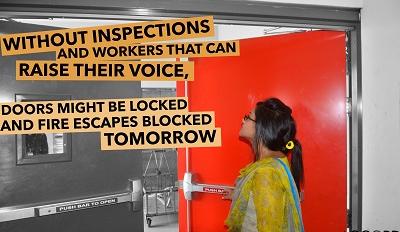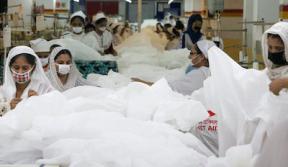
On the night of 20 February a fire broke out and rapidly spread through the densely packed Chawkbazar district in Dhaka, Bangladesh. At least 70 people died in the fire that was exacerbated by illegally stored, highly combustible chemicals in the buildings. This horrible tragedy lays bare a pressing problem in Bangladesh: the use of residential buildings and areas for industrial purposes beyond the ready-made-garment industry, which creates serious safety hazards that remain as yet unchecked by national safety enforcement systems.
As tragic as the fire is, it did not come as a surprise. The dangers of storing chemicals in residential areas has at least been widely acknowledged since a fire in 2010 killed at least 123 people, only a stone’s throw away from the site of the latest disaster. Promises to relocate chemical factories were not followed up. This points at the issue that lies at the core of all of these tragedies: intentions can be good, but the implementation, monitoring, and enforcement of safety standards is arduous work that requires capacity and political will to let safety prevail over factory owners’ interests of keeping costs down through cutting corners on safety and avoiding regulation.
Safety in the ready-made-garment sector: Accord on Fire and Building Safety in Bangladesh
The contrast with the world-wide outcry after the 2012 (Tazreen Fashions) and 2013 (Rana Plaza) mass casualties in garment factories is striking. Under immense public pressure, unions, apparel brands, and NGOs agreed on a programme to fill existing gaps in safety enforcement. It is this Accord on Fire and Building Safety in Bangladesh that many now turn to as an example. Civil engineering professor Ishtiaque Ahmed told Reuters that genuine safety monitoring, such as practiced by the Accord, could make a real difference: “The only reason why fire accidents in the garment industry (have) decreased is because Accord has constantly monitored the factories since 2013. (…) If there’s a strong team to monitor the housing industry, a lot of fire accidents can be controlled.” Bangladeshi lawyer Sara Hossain, who represented victims of the 2010 fire, brought up the same example to the Wall Street Journal. Both she and Bangladesh’s fire department’s director general, Ali Ahmed Khan, point out that international pressure brought about a transformation to industrial safety in the garment sector, but this change has failed to extend to other sectors.
In the almost six years since the Rana Plaza collapse, the Accord has brought unprecedented new safety levels to Bangladesh’s garment sector, even if a number of factories are still awaiting essential remediation measures. Nevertheless, since early 2018, the Accord has been at risk of being expelled from Bangladesh, with both the government and factory owners claiming that the government of Bangladesh’s inspection systems are ready to take over the Accord’s work.
More capacity needed to improve on safety in other sectors
The national inspection agencies in Bangladesh would, however, better serve the people of Bangladesh if they decided to put their capacity where it is most needed: all those factories not covered by the Accord. The Department of Inspections for Factories and Establishments (DIFE) lists 29,492 factories under its purview, 5,104 of which are garment factories.
In a September 2018 report, the remediation percentage for garment factories covered by DIFE’s National Initiative was at 29%. This contrasts with the 89% remediation rate announced by the Accord a month later for the 1,572 garment factories it covers. Keeping in mind the widely-held opinion that other sectors are lagging far behind the garment industry, which had has five years to reach these results, the obvious conclusion is that it would be irresponsible to put even more work on the shoulders of these already overburdened institutions.
Rather than putting energy into attempts to gain control over the inspections for the almost 1,600 Accord-covered factories, DIFE should focus on the nearly 30,000 industrial facilities that need its attention much more urgently.
Boiler inspections pose a further example of how lack of capacity has continued to create unsafe situations. Despite Bangladesh’s long history of fatal boiler explosions, their inspection was explicitly left under the responsibility of the government of Bangladesh’s inspection agencies. With only eight boiler inspectors for the whole garment sector, however, these government inspectors have to limit themselves to short visits that do not allow for testing. All these inspectors do is check the paperwork. The inadequacy of this practice showed most recently in July 2017 when a boiler exploded in the Multifabs factory, killing 13 workers and injuring 20. Trying to fill a gap where it saw one, the Accord has started a pilot study into boilers in 50 garment factories. It found that many factory owners used to the minimal inspection capacity previously available plainly refuse to turn off boilers to be tested. The Accord could only test 19 out of 50 boilers, of which only five passed the test.
In a country rife with unsafe buildings, the Accord has shown what can be achieved through meticulous inspections, a commitment to remediation, and worker involvement. With the immense task ahead of inspecting buildings beyond the garment industry, it would be foolish for the government to rush the transfer of responsibilities of the one safety programme that has brought substantial progress. It would be a more thoughtful move for the government to instead use the Accord’s initiative to lighten the government’s burden by allowing the Accord to continue the inspection and remediation of the garment factories under the Accord’s purview, as well as the textile mills and factories and boilers allowed for under the Accord’s 2018 mandate.
The Accord’s work could free up direly needed government capacity to improve the safety situation in chemical factories, non-Accord-covered garment factory, and other sectors. This would also allow ample time for the government to create a genuine transition plan together with the Accord’s signatories for the time beyond the Accord’s 2021 mandate, providing for real solutions by incorporating the vital elements of the Accord’s model towards improving workplace safety: not just its inspections, but also the complaint mechanism and worker trainings. In this way, the government would take responsibility for Bangladesh’s workers and residents and work towards sustainable safety for all.

